How photographers captured the year’s most compelling moments, from events on Capitol Hill to the World Cup
Showcasing some of the standout images of the year along with blow-by-blow accounts of how they came to pass from the men and women behind the camera
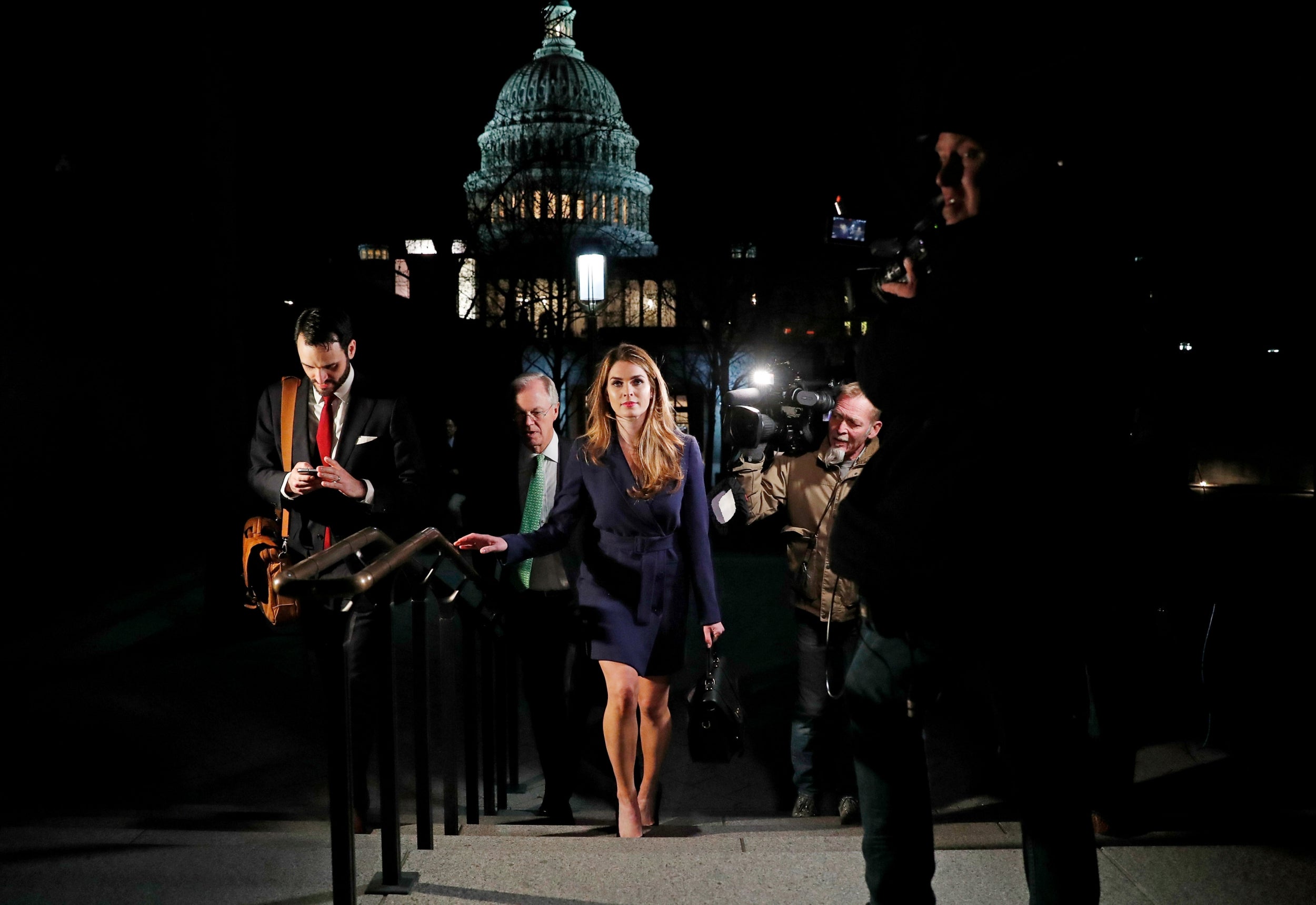
Your support helps us to tell the story
From reproductive rights to climate change to Big Tech, The Independent is on the ground when the story is developing. Whether it's investigating the financials of Elon Musk's pro-Trump PAC or producing our latest documentary, 'The A Word', which shines a light on the American women fighting for reproductive rights, we know how important it is to parse out the facts from the messaging.
At such a critical moment in US history, we need reporters on the ground. Your donation allows us to keep sending journalists to speak to both sides of the story.
The Independent is trusted by Americans across the entire political spectrum. And unlike many other quality news outlets, we choose not to lock Americans out of our reporting and analysis with paywalls. We believe quality journalism should be available to everyone, paid for by those who can afford it.
Your support makes all the difference.These photographers captured the human drama in the most compelling stories of 2018, including desperate Honduran migrants confronted by Mexican riot police, wounded protesters at the Gaza border, Syria war victims rescued from rubble and pile-on victory celebrations at the World Cup in Russia.
This feature showcases some of the standout images of the year along with blow-by-blow descriptions of how they came to pass from the men and women behind the camera.
Leah Millis: “After an earlier assignment in Washington at the Supreme Court in February, I was asked to join colleague Kevin Lamarque at the Capitol, where White House communications director Hope Hicks had been testifying to the House Intelligence Committee.
“After about seven hours of waiting, Hicks suddenly appeared at the end of the hallway. I grabbed my backpack and broke into a sprint towards the northern exit with a videographer and no other photographers.
“We then back-pedalled with Hicks for the long walk up the stairs that lead to First Street from the Capitol. I noticed the lit-up Capitol building behind her as we climbed the stairs and had the presence of mind to get it in the background of the photograph.
“When we reached the top of the steps, Hicks and her team hailed a taxi, got in and they were off. Seven hours of waiting had culminated in a few minutes-long feverish dash and climb up the stairs. Hicks and myself were the only women at the scene.
“One of the videographers made a comment about her looks as we were walking, and I felt the need to show that she held her own, never stumbled or looked like a victim in that situation.
“Moments like these transcend barriers. I’m a photojournalist and she was my subject in that situation. But, in that moment, I could relate to her from one woman to another.”
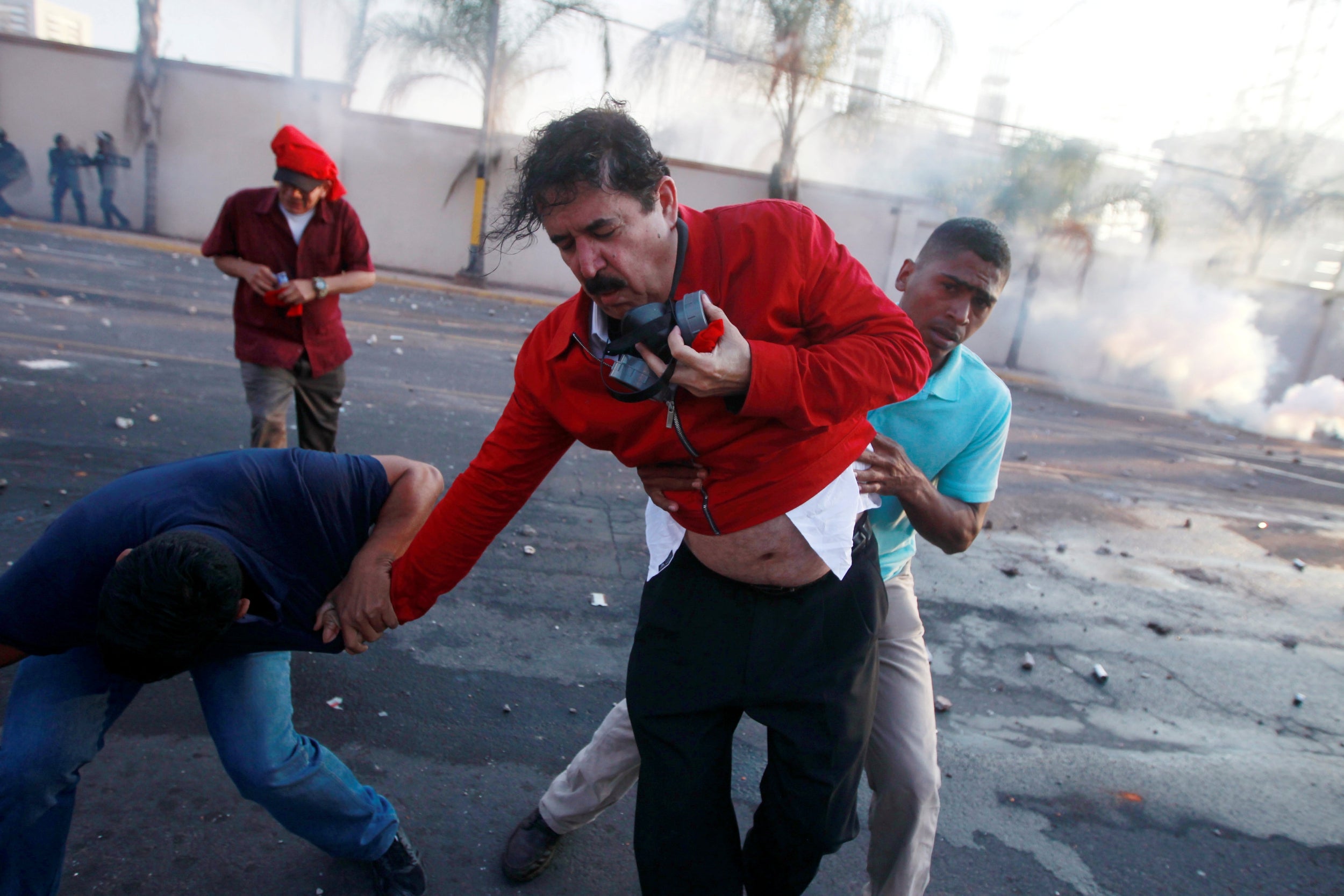
Jorge Cabrera: “I was covering a protest against Honduran president Juan Orlando Hernandez in the capital Tegucigalpa when things turned violent.
“Some protesters vandalised the front of the Marriott Hotel, and police responded with teargas and warning shots. Among the protesters was former president Manuel Zelaya. Zelaya tried to quell the clashes but got caught in the middle of the scuffle and his hat fell on the ground. As he tried to retrieve it, Zelaya was gassed and attacked by police.
“The photo I took captured his bodyguards as they tried to get him to safety while Zelaya catches his breath, holding a gas mask.What struck me the most was how the former president seemed to ignore the danger – the teargas and bullets – and he appeared solely focused on getting his hat back. But police soon charged again, and Zelaya never managed to retrieve it.”
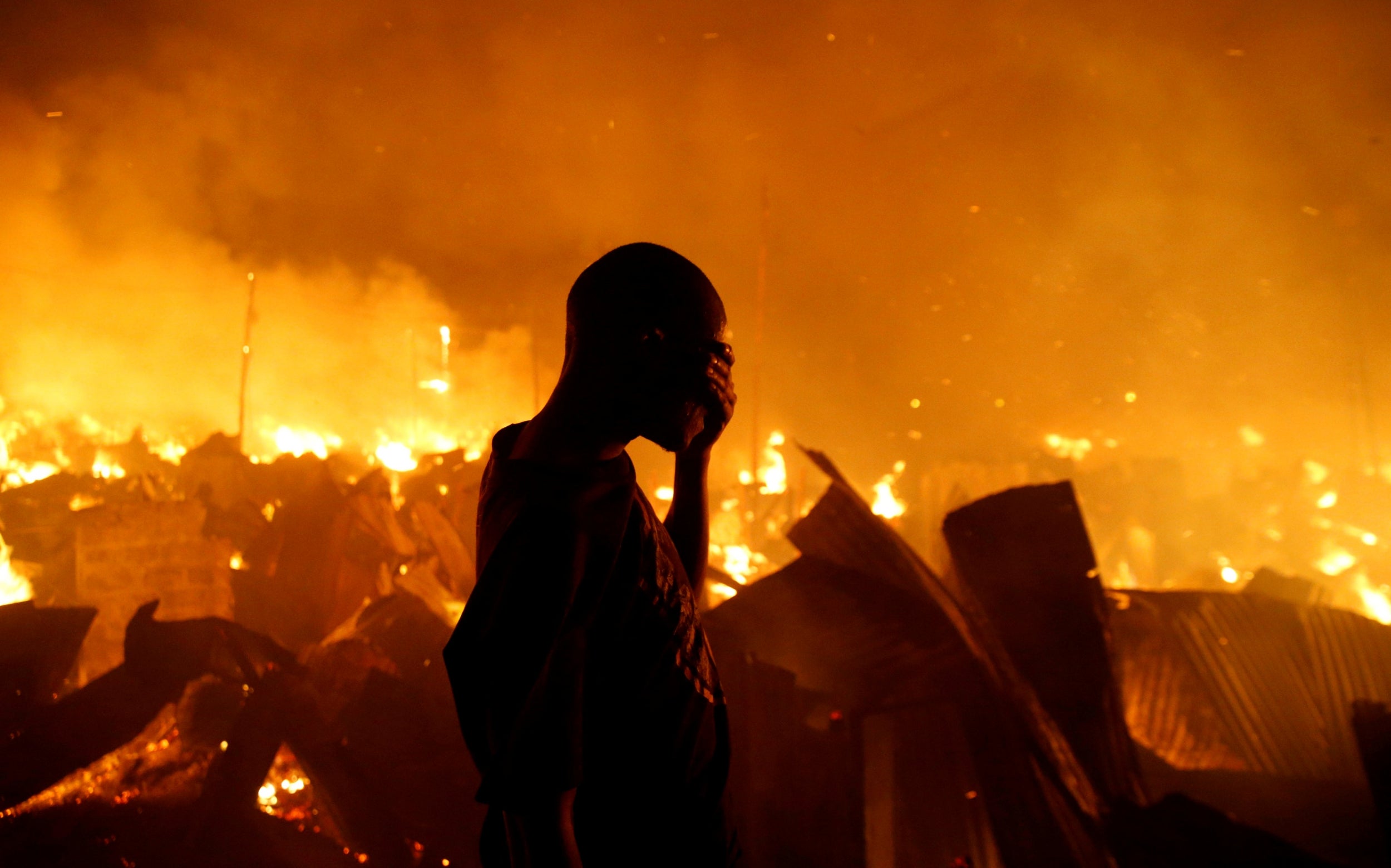
Thomas Mukoya: “On a Sunday night in January, I was watching the news before going to bed when images of a fire in a poor Nairobi neighbourhood popped on the screen.
“I grabbed my cameras and rushed to the scene in the Kijiji slums of Southlands Estate, where fire had engulfed the entire shanty town and many residents were reported missing.
“When I arrived, I saw residents attempting to recover their belongings among the charred ruins.
“Some were trying to salvage goods from their businesses that had been consumed by the flames. The scene was chaotic as the firefighters had run out of water and residents were crying for their missing relatives.
“Some women were carrying their children away from the heat of the inferno when I noticed a man sifting through the burning rubble of what used to be his home.
“When I approached him, he was emotional and paid little attention to me. After a few minutes, he stood up and wiped tears from his face as I snapped the photo.
“Then he asked me, ‘Is this what the government can do to the people who voted it into office?’
“I told him I would use my pictures to tell the story of the disaster that had befallen them, and I reassured him that help would be coming soon. ‘I’d rather die!’ he shouted as I walked away.”
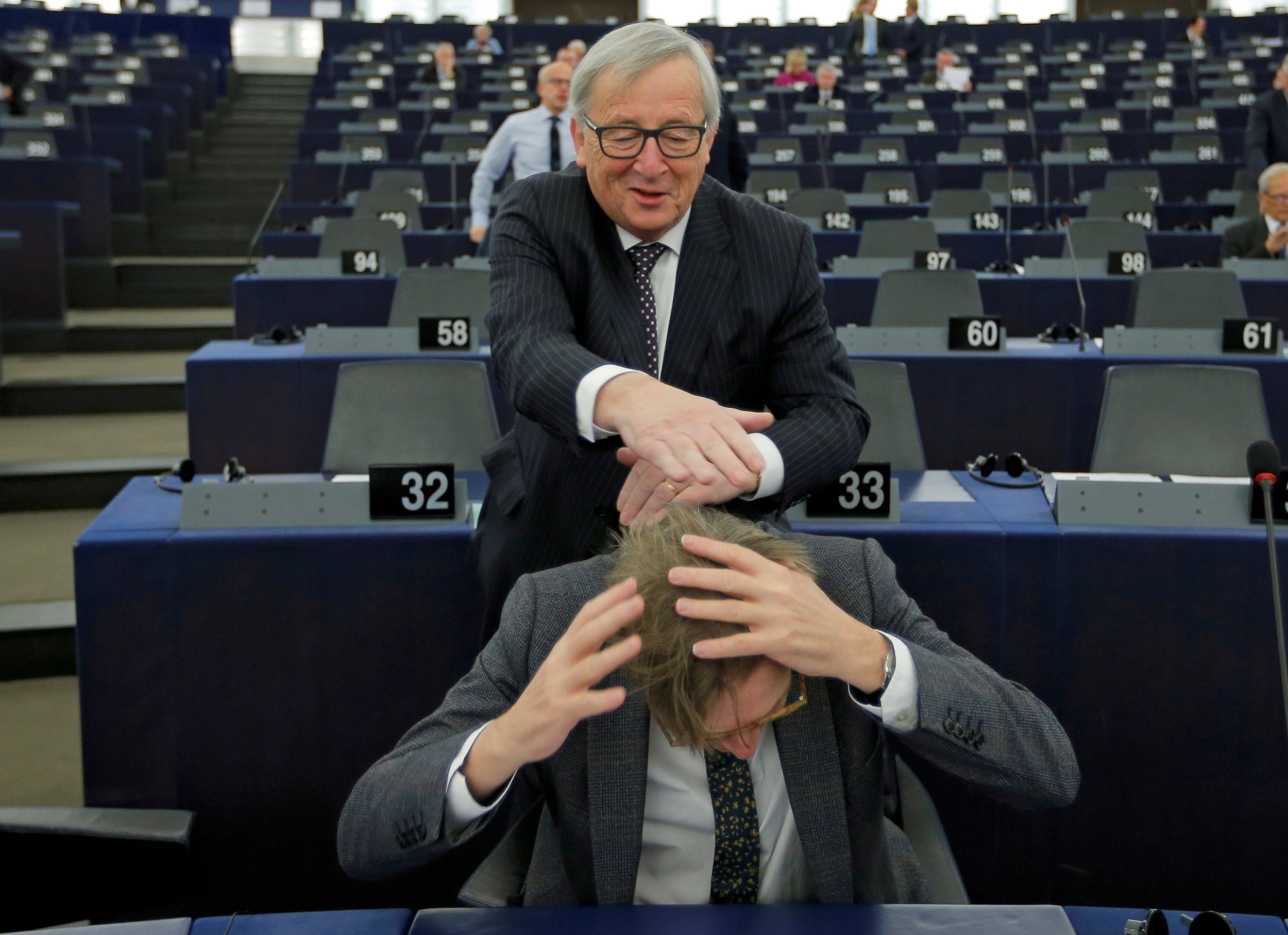
Vincent Kessler: “Covering sessions at the European parliament involves attending a succession of debates with a succession of speakers producing a succession of similar pictures.
“European Commission president Jean-Claude Juncker is always one of the first to arrive in the plenary room, so I usually come early myself to try to take pictures different from the ones we can expect in the official frame of the debate.
“At this time of the day, 15-30 minutes before the start of the debate at 9am, the plenary room is quite empty, giving Juncker the opportunity to have a chat or joke with MEPs or even with photographers.
“Also in the plenary room was Guy Verhofstadt, president of one of the political groups in the European Parliament and the EP’s chief negotiator on Brexit.
“He also ran against Juncker when the latter was elected president of the commission in 2014. The two know each other well, having also served as prime ministers of their neighbouring countries, partly at the same time.
“So an opportunity to take pictures of the two together is always interesting and this is why I decided to stand in front of Verhofstadt in the plenary room, waiting for Juncker to come over.
“Juncker is a character, always breaking the rules and ready to laugh and especially at himself. As Verhofstadt was reading some papers, Juncker discreetly snuck up behind him and ruffled his hair, giving us the opportunity of a nice and funny picture. Not the kind you usually expect in one of the hundreds of debates I have covered in parliament.”
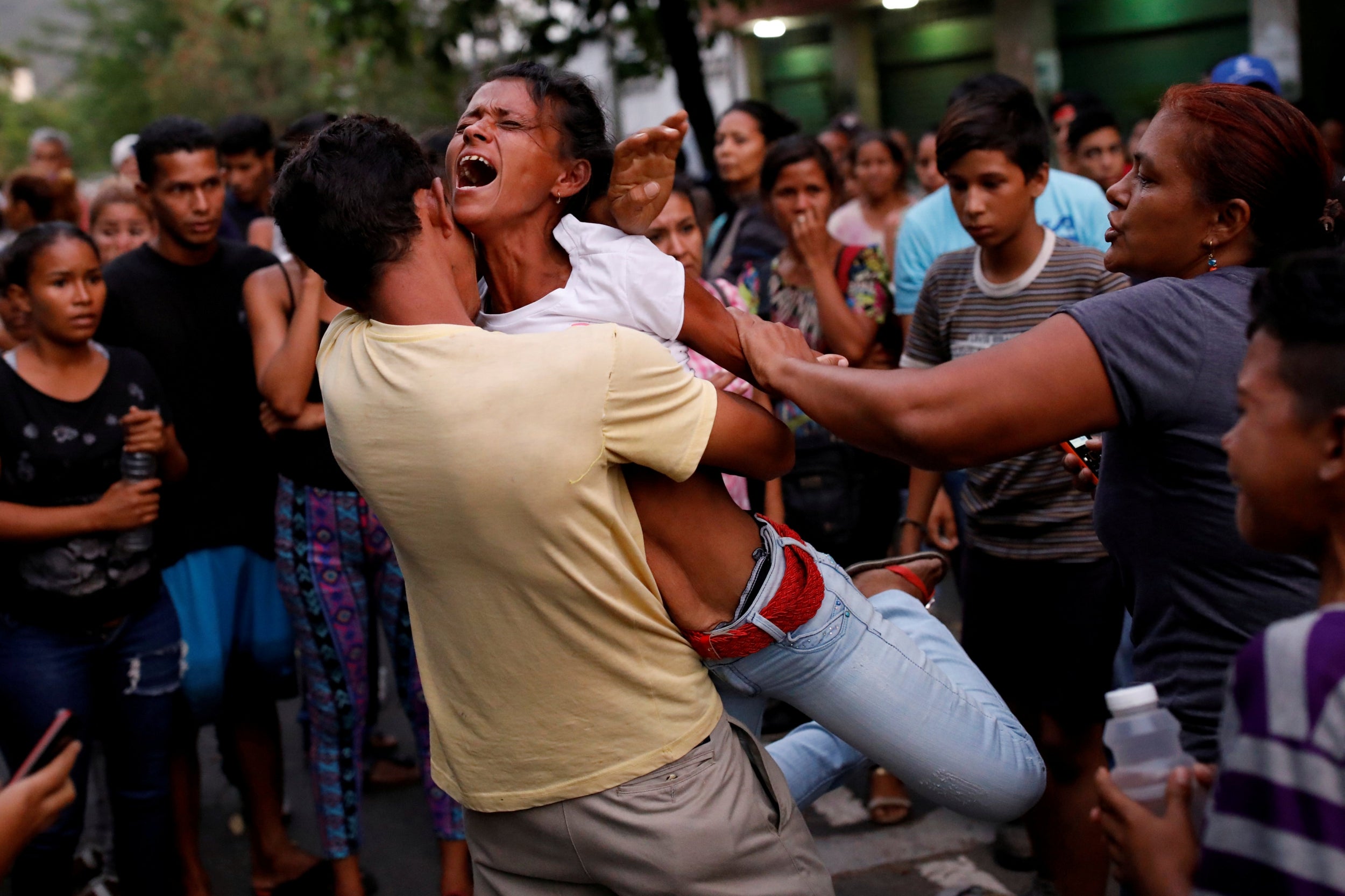
Carlos Garcia Rawlins: “When we heard that riots and a fire had broken out in the cells of a detention centre in Valencia, we knew that it was a possible catastrophe as many prisons in the country are overcrowded.
“There were rumours of dozens of deaths and there was a desperate atmosphere as a crowd of several hundred people waited for news of their loved ones. Earlier in the day there had been clashes and the police had used teargas to disperse the families.
“Police officers were trying to update people, but no official statements had been made, and as people heard news of their relatives in the detention centre, a reaction would spread through the crowd.
“People were crying, fainting and shouting throughout the street. I was standing on the other side of the street when I heard a woman’s scream pierce the air.
“I rushed through the crowd and saw this woman. She was overwhelmed by grief and people cleared a space around her and tried to comfort her.
“This was a really difficult moment to photograph because her pain was so intense, I don’t think she even really noticed I was there. Authorities subsequently said that 68 people died in the fire, including two women who were visiting inmates.
“I spent the following day documenting the funerals of some of those who had died.”
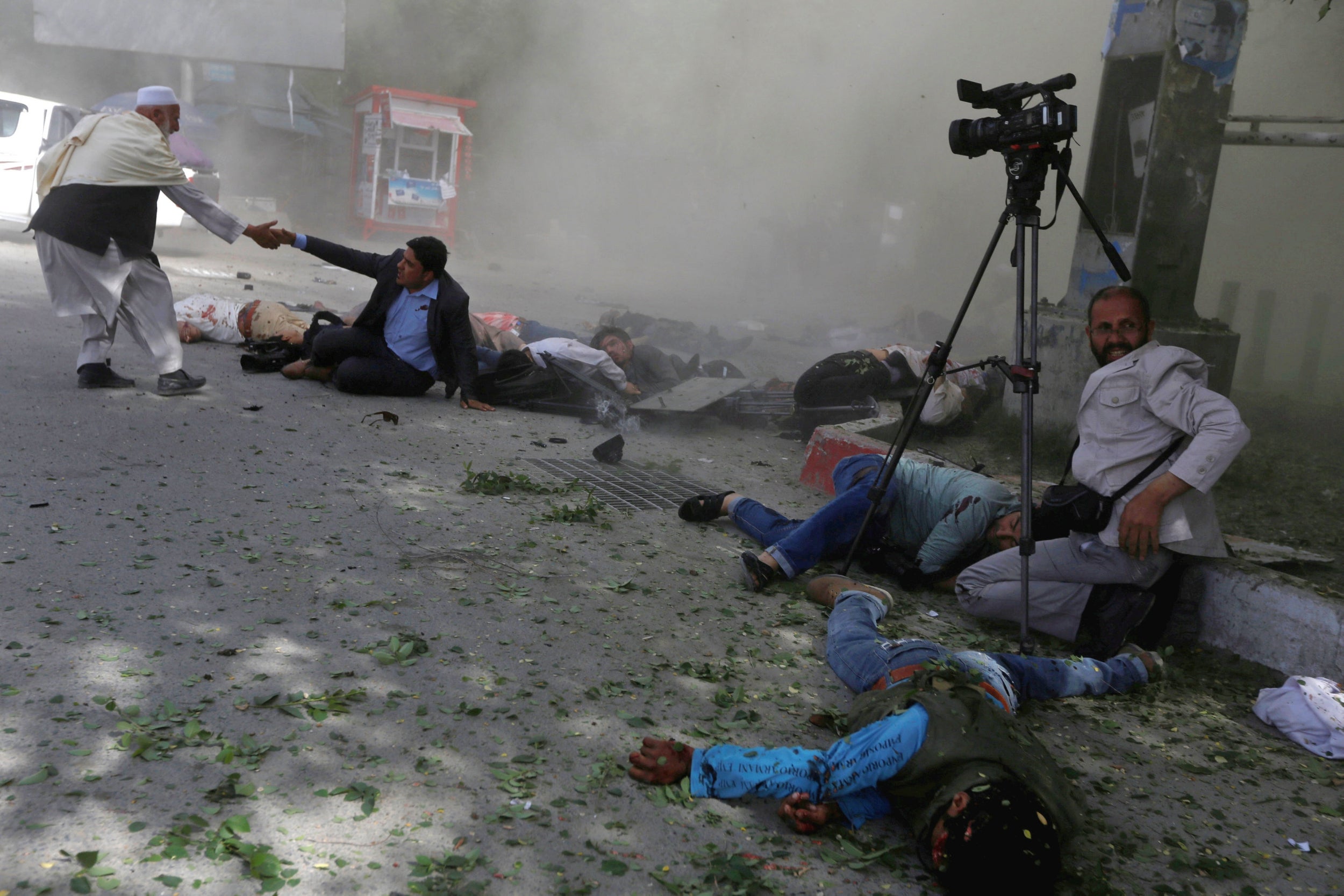
Omar Sobhani: “I shot this photo 10 or 15 seconds after the suicide bomber detonated his explosives in Kabul.
“I had been waiting with other journalists to cover an earlier blast. It was about 8.30 in the morning, there were security forces guarding the site of the first blast and quite a few people going to work and we were just waiting with other journalists.
“Then we heard a huge bang just behind me. I survived because I was standing in front of a concrete pillar that shielded me from the force of the explosion, but I saw my friends and colleagues on the ground and a lot of them were dead and a few injured – you can still see the smoke from the explosion in the pictures.
“I was slightly wounded, but was able to quickly capture some images of the scene before withdrawing to seek help. I was shocked but I could see there was nothing to be done and I shot some pictures immediately before leaving.
“I could feel some pain and there was some shrapnel in my shoulder, which was taken out at the hospital. Eight of the journalists were from Afghan outlets. The French news agency AFP’s chief photographer in Afghanistan, Shah Marai, was also killed.
“For me and the other journalists at the scene, the dead were colleagues and friends. The people killed were all innocent people, people just going about their business or journalists just doing their job.
“They’re showing the truth of what’s happening. It’s not politics. It’s very important so that people can know what’s happening. It’s a challenging job. You see war and violence all the time but it’s important to make sure people know.
“I was very shocked – these were colleagues of mine and one was a very good friend.”
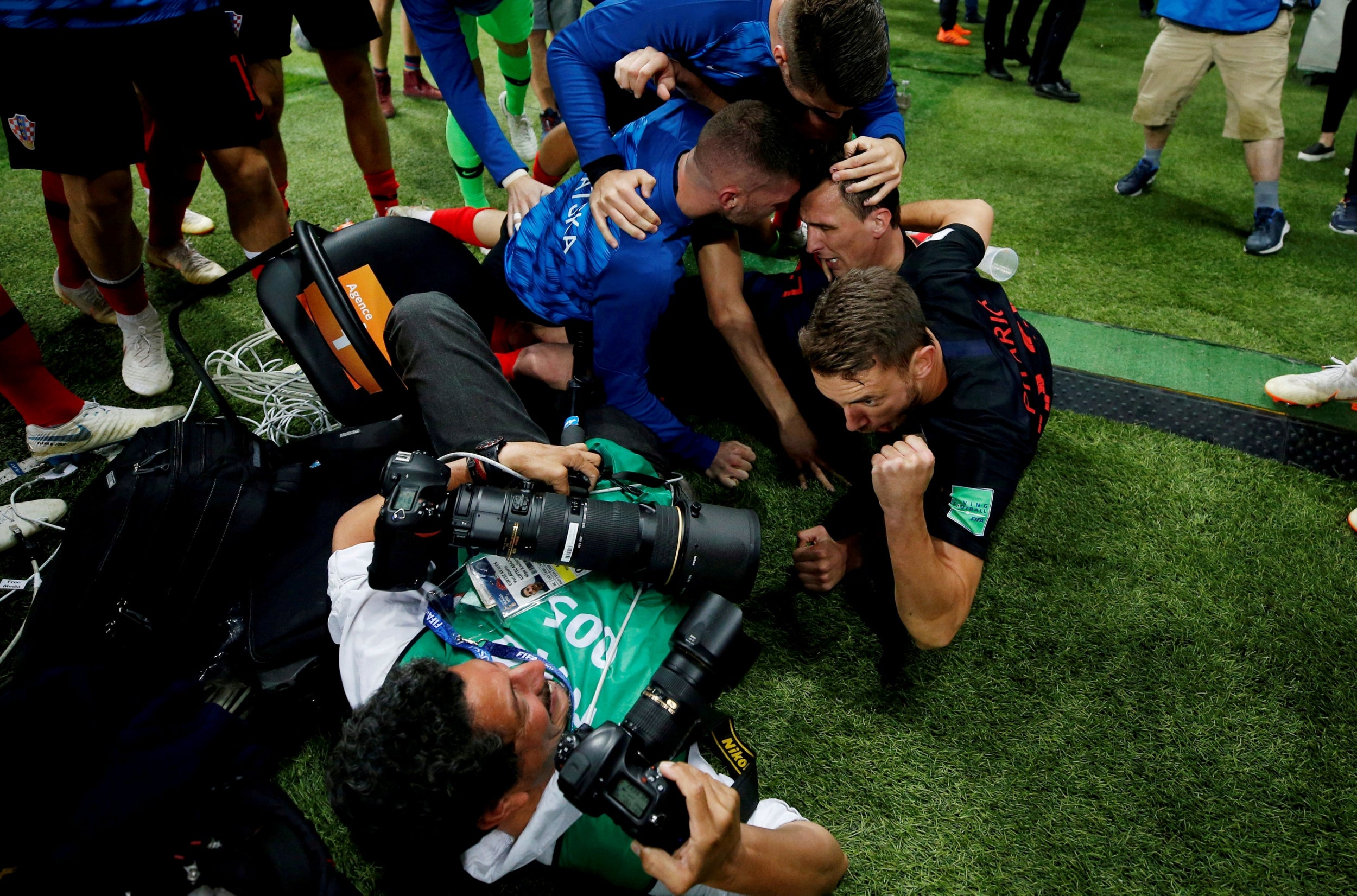
Carl Recine: “It was the 2018 World Cup semi-final – England and Croatia were facing off. I had secured a pretty good seat throughout the tournament and things had gone pretty well for me, with plenty of goals and celebrations coming my way.
“The teams were tied 1-1 in the second half of extra time, and the next goal would take whoever scored to the final. Croatia went on the offence and soon enough Mario Mandzukic scored the crucial goal.
“I had that photo in the bag and now Mandzukic was running right towards me. Suddenly he was right in front of me, filling the frame of my 70-200mm lens. I always try to keep a wider 16-35mm lens close by for moments like this, though they rarely happen.
“In fact, I had never found myself in a similar situation before. As his teammates stormed towards him to celebrate, I jumped off my seat to avoid being swept up by the whole Croatian team.
“But another photographer who was sitting next to me was accidentally knocked to the floor. I kept photographing the celebrations, which now engulfed my colleague. This made the photograph even more unusual.
“The Croatian players then picked the photographer up, made sure he was okay, found his glasses on the floor and placed them back on his head. It was a special and unique moment, and I was delighted to be part of it.”
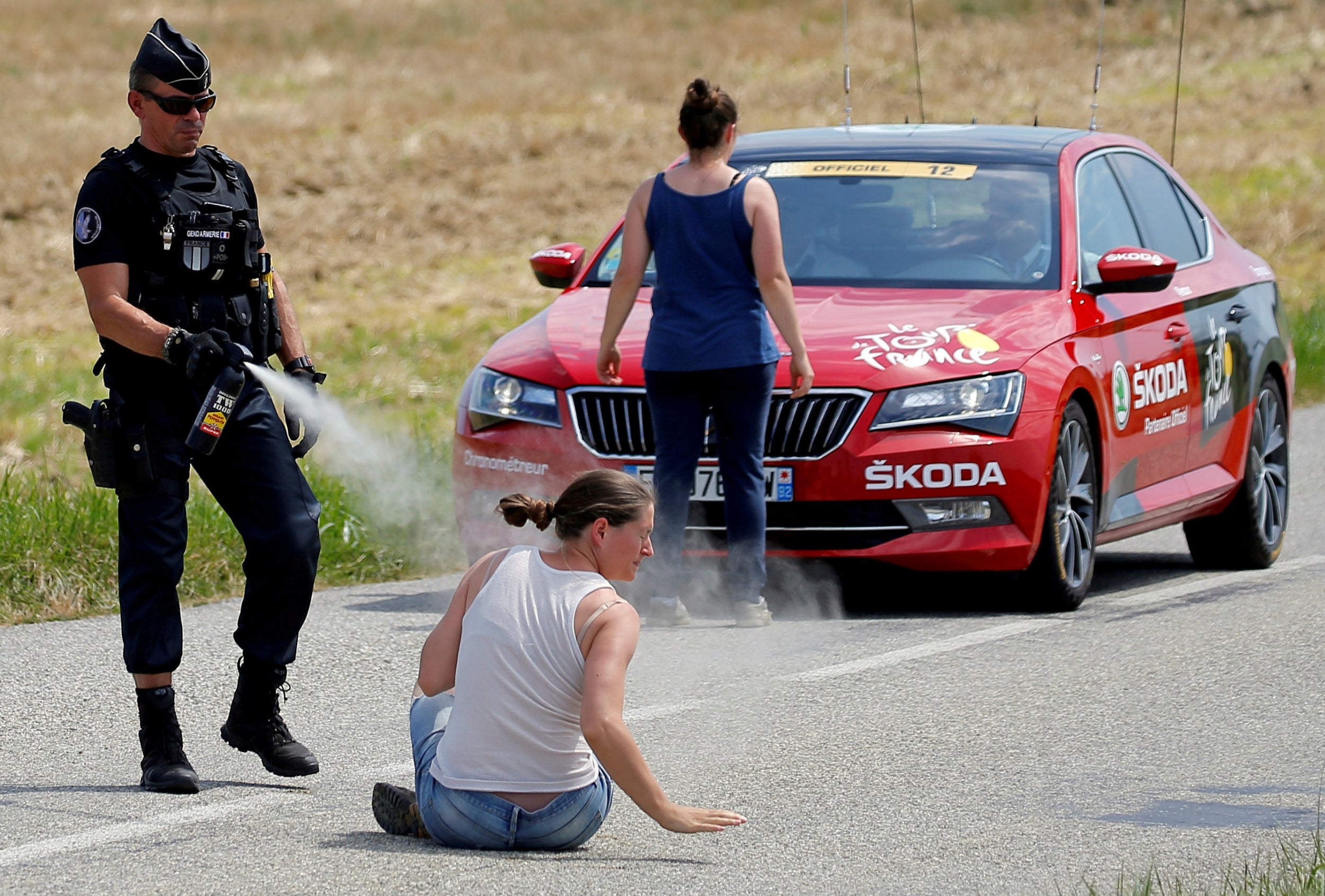
Stephane Mahe: “The Tour de France was in its final days. I was aboard a motorbike following a long 218-kilometre stage from Carcassonne in the deep southwest of France up to the Pyrenees.
“In the early part of the stage I got a little frustrated, unable to find a ‘postcard’ image or vantage point to shoot the race. After 25 kilometres, the motorbikes were told to gather three kilometres further along.
“Something was happening at last! I could see a flock of sheep with farmers and police. I jumped down and started to imagine a photo with sheep and the Tour peloton.
“As I got closer I quickly felt the tension: farmers were there with their livestock and tractors to demonstrate, not to watch the riders. I realised they intended to block the race.
“The Tour security asked me to leave but I decided to stay as something more than a sporting episode was unfolding.
“Just before the arrival of the peloton, I saw two young women rush onto the road, shouting and blocking an official Tour car as farmers cheered them on.
“The gendarmes immediately sprayed teargas at the two protesters, who screamed and struggled. I took my picture. The two women were quickly removed from the road and the peloton arrived.
“The cyclists slowed and then stopped, troubled by the teargas in the air. They struggled to breathe, wiped their eyes. One even asked me if someone had thrown acid in his face. It was chaos.
“The race was held up for 17 minutes – very unusual. I thought of the two protesters, I knew it was a striking image.
“That evening, after this stage of Tour was over, I discovered that the photo had gone viral. The protesters had an audience for their fight against the loss of local farming subsidies. But the Tour went on.”
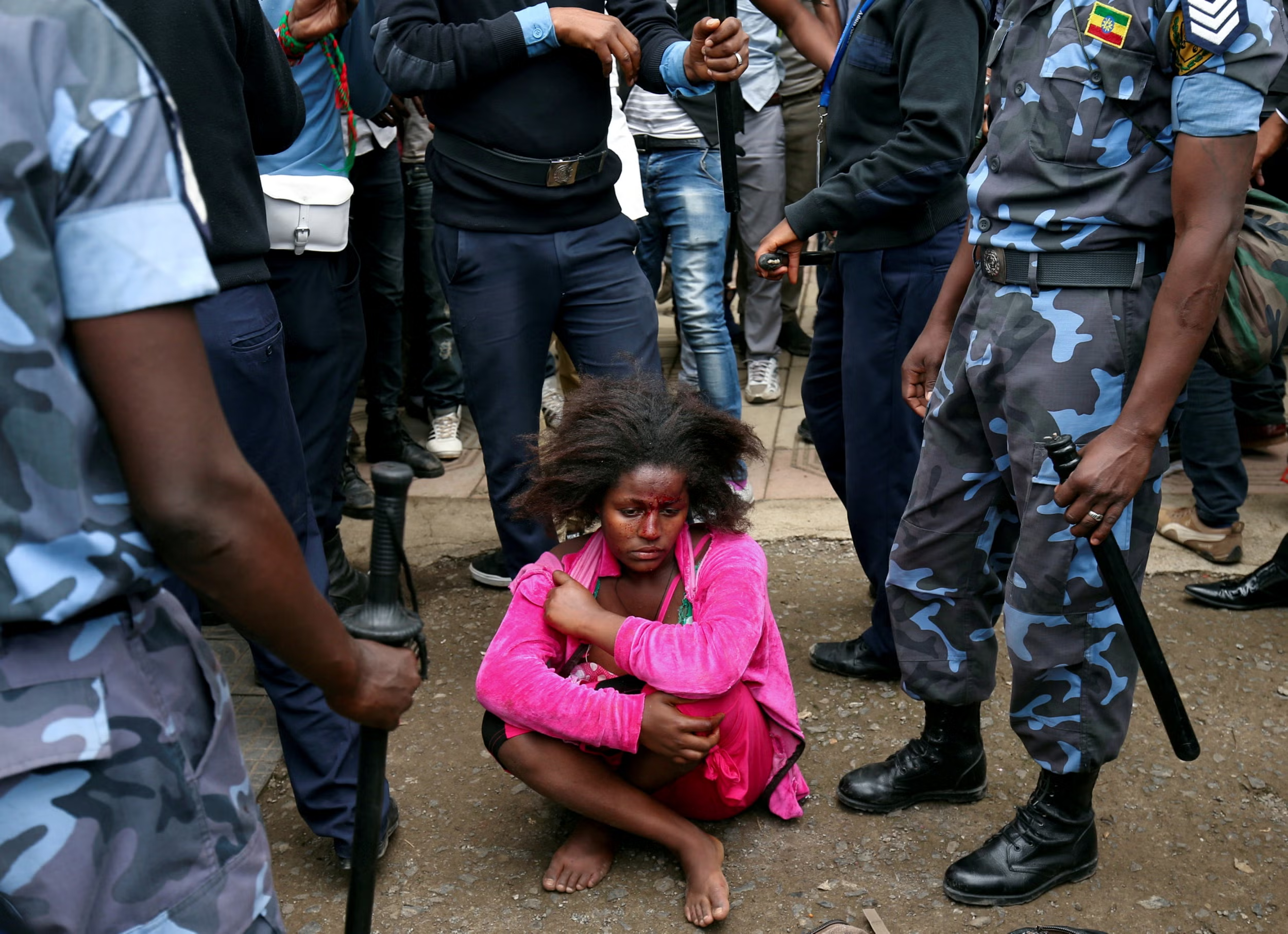
Tiksa Negeri: “The fifth of August was a joyous day for thousands of young ethnic Oromo youths in Ethiopia as they celebrated the return of Jawar Mohammed, the exiled leader of their struggle who is a US-based social media activist.
“The youths were dancing and chanting slogans in front of Addis Ababa’s Bole International Airport as they waited for their hero to land there. Some youths were assigned as security guards to check people arriving for the celebration and accompanying concert.
“I was out on the street to shoot the event. The atmosphere was joyous, everybody enjoying themselves, holding up Jawar portraits.
“About 30 minutes later, however, I bumped into some angry youths beating a young woman who apparently had refused to be checked and was suspected of carrying explosives.
“I followed them as they hustled her towards police. I was glad she was finally handed to police custody in one piece and she was taken away for investigation.
“I never heard of reports about her after that. I felt like I was in the right place to get the handover of the young woman, with her regretful expression, and I immediately got on my knees and took this picture.
“Not long after she was taken away, the crowd got back into the mood of dancing and celebration.”
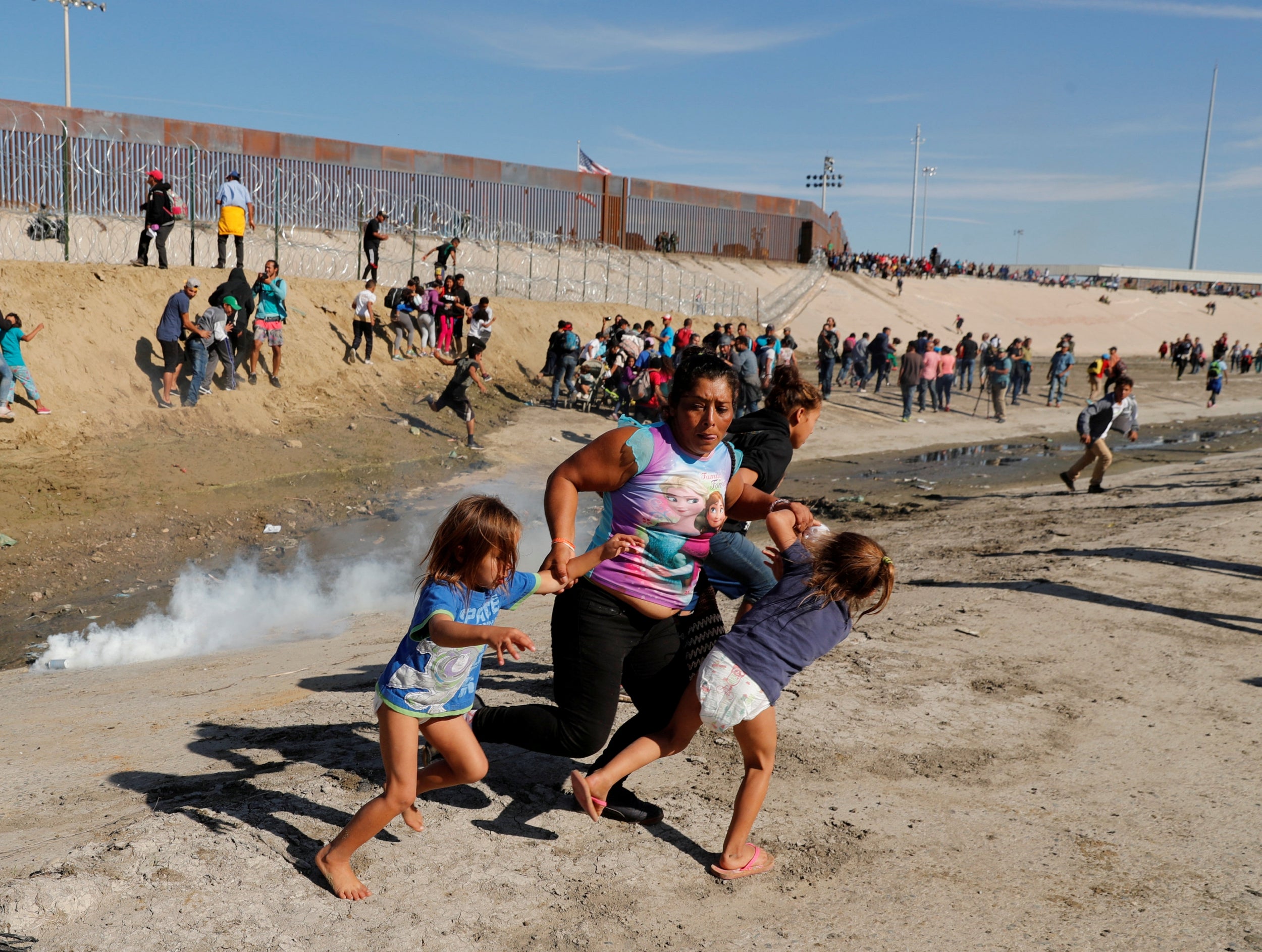
Kim Kyung-Hoon: “After nearly two weeks of documenting the harrowing journey of a caravan of mostly Central American migrants headed towards the US-Mexican border, I snapped a picture I will never forget.
“In the photo, Honduran mother Maria Meza grabs the thin arms of her two five-year-old twin daughters Cheili and Saira as they frantically run from a teargas canister next to the US-Mexico border barrier in Tijuana. Cheili is in diapers, Saira barefoot.
“Their mother is wearing a T-shirt from the Disney hit Frozen, a movie I’ve seen many times with my own daughter.
“In the frantic moments after teargas canisters hit the ground, the acrid smell engulfed the area. Children were crying, their eyes stung by the gas.
“The US government said customs officers had used teargas to stop a group of migrants who, they said, had violently attempted to cross the border.
“I did not see who fired the canister, but I heard the sound come from the direction of the border fence as I, too, broke into a run.
“It was one of the first of several teargas canisters I saw being used by border agents. I did not witness migrants behaving violently, but we were in a large area and I could not see everything that was happening.
“It is not my place to say who is right and who is wrong. I just took a photo of what I saw happening in a given place and time.”
Reuters
Join our commenting forum
Join thought-provoking conversations, follow other Independent readers and see their replies
Comments